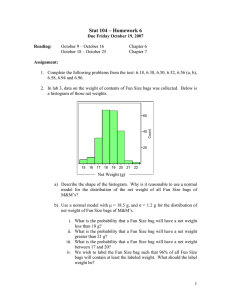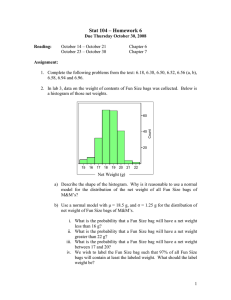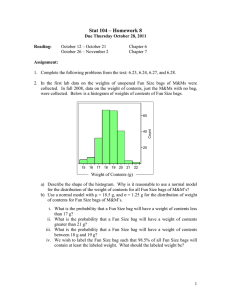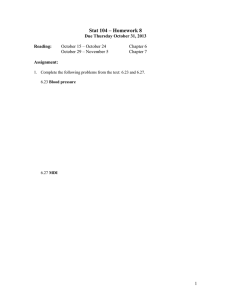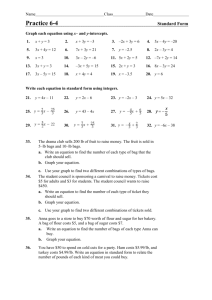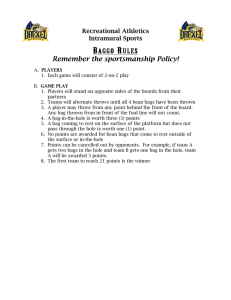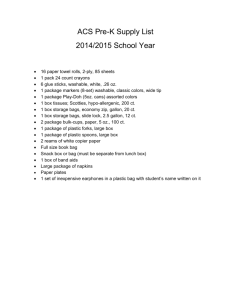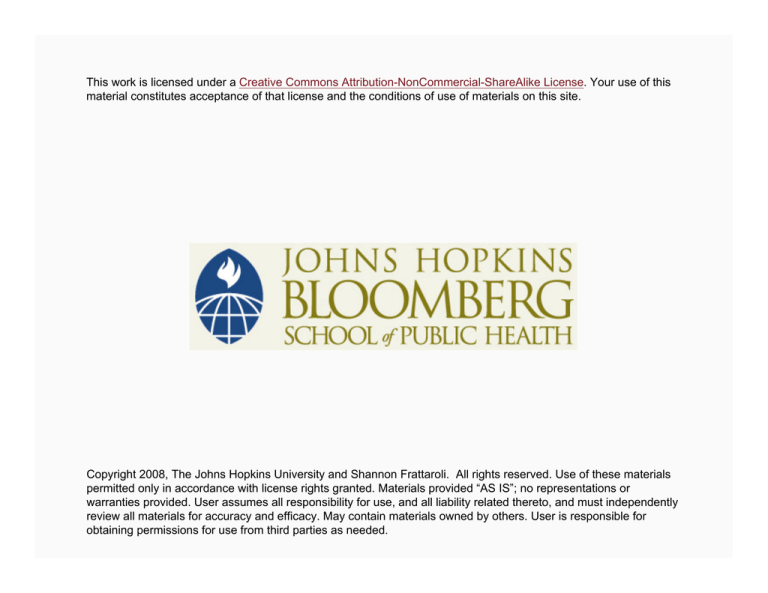
This work is licensed under a Creative Commons Attribution-NonCommercial-ShareAlike License. Your use of this
material constitutes acceptance of that license and the conditions of use of materials on this site.
Copyright 2008, The Johns Hopkins University and Shannon Frattaroli. All rights reserved. Use of these materials
permitted only in accordance with license rights granted. Materials provided “AS IS”; no representations or
warranties provided. User assumes all responsibility for use, and all liability related thereto, and must independently
review all materials for accuracy and efficacy. May contain materials owned by others. User is responsible for
obtaining permissions for use from third parties as needed.
How Did an Air Bag Get into My Steering Wheel?
A Case Study in Injury Prevention Policy
Shannon Frattaroli, PhD, MPH
Johns Hopkins University
Introduction
Overview
− Apply Bardach’s framework to the U.S. motor vehicle
injury problem
− Review air bag policy history
− Analyze the political, policy, and legal ramifications for
pursuing mandatory air bag policy in the U.S.
3
Section A
Motor Vehicle Injuries as a Public Health Issue
Air Bag Policy in the U.S.—An Introduction
Injury is a leading cause of death and disability
Motor vehicle injuries are the leading cause of injury mortality
Motor vehicle injuries are the leading cause of death for
people 4–33 years old
Over 90 percent of transportation fatalities are traffic related
Motor vehicle crashes caused more than 40,000 deaths and
more than 3 million nonfatal injuries in 2001
Source: NHTSA. (2001). Traffic safety facts.
5
The Problem
Too many people die and are seriously injured as a result of
motor vehicle crashes
Technology is available to protect motor vehicle occupants
from “secondary crash”
− How best to bring that technology to the market is a
subject of debate
6
The Evidence I
Mortality
− During the 1980s, approximately 45,000 died annually as
a result of motor vehicle injuries
− Motor vehicle–related deaths are the largest source of
injury deaths
− About one-third of motor vehicle deaths occurred among
15–24 year olds
Source: WISQARS.
7
The Evidence II
Epidemiology of car crashes
− Multiple risks factors have been linked to crash risk and
injury severity
X Road conditions, driver factors, vehicle characteristics
8
The Evidence III
Epidemiology of car crashes
− More than 60 percent of motor vehicle fatalities involve
front-end or front-corner collisions; in comparison, less
than 5 percent of rear and rear-corner impact crashes
result in death to the occupants
Source: Baker, S. P. et al. Injury fact book.
9
The Evidence IV
Economics
− Motor vehicle injuries were estimated to cost
approximately $49 billion in lifetime costs in 1985
Source: Rice and MacKenzie. Cost of injury in the United States.
10
Section B
Continuing with the Policy Analysis Procedure
Air Bag Policy in the U.S.—Alternatives
Air bags
Safety belts
Driver education
Enhanced enforcement of existing drinking and driving laws
12
The Criteria
Reduce deaths
Reduce severity of injuries
Easy to use
Ready to implement
Universally applicable
Affordable
Easy to maintain
13
Air Bag Policy in the U.S.—Projected Outcomes I
Air bags
Safety belts
Driver
education
Enforcement
Reduce deaths
Reduce injury
Ease of use
Ready to
implement
Universal
Affordable
Easy to
maintain
14
Projected Outcomes II
Air bags
Safety belts
Driver
education
Enforcement
Reduce deaths
++
++
0
+
Reduce injury
++
++
0
+
Ease of use
+++
+
0
+
Ready to
implement
+
+
+
++
Universal
+++
++
+
+
Affordable
+
++
+
++
Easy to
maintain
++
+
+
++
15
Projected Outcomes II
Air bags
Safety belts
Driver
education
Enforcement
Reduce deaths
++
++
0
+
Reduce injury
++
++
0
+
Ease of use
+++
+
0
+
Ready to
implement
+
+
+
++
Universal
+++
++
+
+
Affordable
+
++
+
++
Easy to
maintain
++
+
+
++
16
Projected Outcomes III
Post-assessment policy alternatives
− Air bags
− Safety belts
17
Projected Outcomes IV
Government and industry projections on effectiveness of air
bags
Controversy between pro-regulatory community and auto
industry
18
Projected Outcomes IV
Government and industry projections on effectiveness of air
bags
Controversy between pro-regulatory community and auto
industry
19
Air Bag Policy in the U.S.—Trade-offs
Considering the public’s health
− From a public health perspective, we are interested in the
secondary crash, or the collision that occurs inside the
involved cars in response to crash forces
Maximizing resources
20
Decide
Mandatory air bag policy
21
Air Bag Policy in the U.S.—Story
Elements of a story in support of mandatory air bag policy
− A motor vehicle death that could have been prevented
with an air bag
− Emphasize the magnitude of the problem
− Emphasize the preventability of the problem
− Need for government intervention to assure minimum
safety standards; don’t want technology differentially
applied
− Passive protection and low seat belt usage
− Universal impact—everyone spends time in a car
22
Section C
What Really Happened with Air Bag Policy?
Air Bag Policy in the U.S.—Part Two
How air bag policy happened
− Beyond Bardach
Policy analysis skills—analyzing political, policy, and legal
ramifications of the decision
24
Policy Analysis and Practice I
Chronology of air bag policy
− Setting
− Innovation
− Action
25
Policy Analysis and Practice II
Chronology of air bag policy
− Resistance
− Inaction
− Response
26
Policy Analysis and Practice II
Chronology of air bag policy
− Resistance
− Inaction
− Response
27
Policy Analysis and Practice III
Chronology of air bag policy
− Final rule
− Standard 208
28
Section D
Role of Regulation, Legislation,
and Litigation in the Policy Process
Air Bag Policy in the U.S.—Overview of Policy Tools
Regulation
Legislation
Litigation
30
Examples of Regulatory Actions
Government interest
Department of Transportation role in standards regarding air
bags
Consideration of industry petitions for delay
Consideration and negotiation of voluntary action by industry
Research
31
Litigation
Auto industry vs. government
Insurance industry vs. government
Individuals vs. industry
32
Litigation
Auto industry vs. government
Insurance industry vs. government
Individuals vs. industry
33
Examples of Legislative Actions
Amend and create legislation providing regulatory authority
Commission GAO reports
Respond to use of regulatory authority
Pass laws specifying standards
34
Section E
Update and Lessons Learned
Air Bag Policy in the U.S.—Post-mandate
Ongoing debate and new technology
− Children and small-stature adults
X On-off switch
X De-powered air bags
X Smart air bags
− Side impact air bags
36
Air Bag Policy in the U.S.—Post-mandate
Ongoing debate and new technology
− Children and small-stature adults
X On-off switch
X De-powered air bags
X Smart air bags
− Side impact air bags
37
Lessons for Public Health Policy
Role of multiple strategies and perspectives to accomplish
this aim
Relationship between industry and advocacy
− Costs and benefits of adversarial relationships?
Policy is not a finite process (Beyond Bardach)
− Implementation
− Revision
38
Lessons for Public Health Policy
Role of multiple strategies and perspectives to accomplish
this aim
Relationship between industry and advocacy
− Costs and benefits of adversarial relationships?
Policy is not a finite process (Beyond Bardach)
− Implementation
− Revision
39
Lessons for Public Health Policy
Science and statistics
− Different standards of proof
− Difficulty in predicting future impact
− Range of estimates and power of assumptions
40
Message to Future Policy Professionals
Patience
Persistence
Flexibility
Perspective
41


